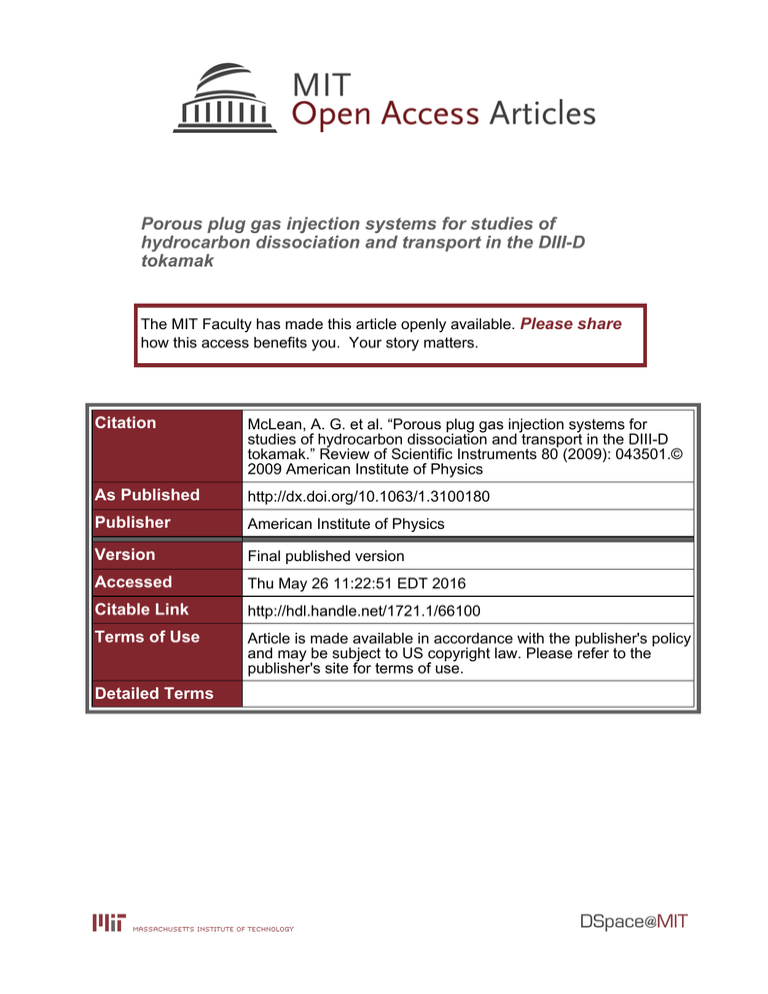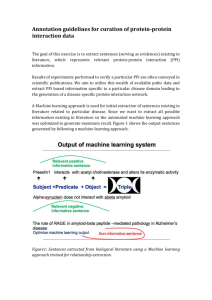Porous plug gas injection systems for studies of tokamak
advertisement

Porous plug gas injection systems for studies of hydrocarbon dissociation and transport in the DIII-D tokamak The MIT Faculty has made this article openly available. Please share how this access benefits you. Your story matters. Citation McLean, A. G. et al. “Porous plug gas injection systems for studies of hydrocarbon dissociation and transport in the DIII-D tokamak.” Review of Scientific Instruments 80 (2009): 043501.© 2009 American Institute of Physics As Published http://dx.doi.org/10.1063/1.3100180 Publisher American Institute of Physics Version Final published version Accessed Thu May 26 11:22:51 EDT 2016 Citable Link http://hdl.handle.net/1721.1/66100 Terms of Use Article is made available in accordance with the publisher's policy and may be subject to US copyright law. Please refer to the publisher's site for terms of use. Detailed Terms REVIEW OF SCIENTIFIC INSTRUMENTS 80, 043501 共2009兲 Porous plug gas injection systems for studies of hydrocarbon dissociation and transport in the DIII-D tokamak A. G. McLean,1,a兲 J. W. Davis,1 P. C. Stangeby,1 N. H. Brooks,2 R. M. Ellis,3 A. A. Haasz,1 D. L. Rudakov,4 W. P. West,2 D. G. Whyte,5 and C. P. C. Wong2 1 Institute for Aerospace Studies, University of Toronto, 4925 Dufferin St., Toronto, Ontario M3H 5T6, Canada General Atomics, P.O. Box 85608, San Diego, California 92121, USA 3 Lawrence Livermore National Laboratory, P.O. Box 808, Livermore, California 94551, USA 4 University of California, San Diego, 9500 Gilman Drive, La Jolla, California 92093, USA 5 MIT Plasma Science and Fusion Center, Massachusetts Institute of Technology, Cambridge, Massachusetts 02139, USA 2 共Received 5 February 2009; accepted 25 February 2009; published online 3 April 2009兲 A probe has been designed, constructed, and successfully used to inject methane into the DIII-D lower divertor in a manner imitating natural release by chemical erosion. This porous plug injector 共PPI兲 probe consists of a self-contained gas reservoir with an integrated pressure gauge and a 3 cm diameter porous surface through which gas is injected into the lower divertor of the tokamak. The probe is positioned flush with the divertor target surface by means of the divertor materials evaluation system. Two gas delivery systems were developed: in the first, gas flow is regulated by a remotely controlled microvalve and in the second by a fixed micro-orifice flow restrictor. Because of the large area of the porous surface through which gas is admitted, the injected hydrocarbon molecules see a local carbon surface 共⬎90% carbon兲 similar to that seen by hydrocarbons being emitted by chemical sputtering from surrounding carbon tiles. The distributed gas source also reduces the disturbance to the local plasma while providing sufficient signal for spectroscopic detection. In situ spectroscopic measurements with the PPI in DIII-D allow the direct calibration of response for measured plasma conditions from a known influx of gas. © 2009 American Institute of Physics. 关DOI: 10.1063/1.3100180兴 I. INTRODUCTION All carbon plasma-facing components in a tokamak are subject to chemical erosion due to impact by hydrogenic plasma species. Although many laboratory-based measurements of erosion yields have been carried out,1–3 their applicability to the tokamak environment is limited due to tokamak-specific mechanisms, such as the presence of a graphite surface immediately nearby which allows prompt redeposition and re-erosion of dissociated hydrocarbon 共HC兲 fragments. Because of the importance of being able to estimate tritium retention in the International Thermonuclear Experimental Reactor 共ITER兲 due to codeposited HCs, the need arose for direct in situ experiments to measure the chemical erosion yield, Y chem, and CD-band and CC-band photon efficiencies for methane and heavier HCs under relevant plasma conditions. A number of methane injection experiments have been carried out on various tokamaks for the purpose of spectroscopic characterization of sputtered products; Ref. 4 provides an early example and subsequent experiments have been well summarized in Ref. 5. To date, gas injection has been accomplished using nozzles or through tile gaps. Such openings are likely to be larger than the mean-free-path for deposition of the molecular fragments resulting from the breakup of the HC molecules due to interaction with plasma electrons a兲 Electronic mail: adam.mclean@utoronto.ca. 0034-6748/2009/80共4兲/043501/8/$25.00 and ions 共⬍10 mm兲. In order to better reproduce the immediate environment experienced by a HC molecule released by chemical sputtering from an essentially continuous carbon surface, a porous gas injection surface was developed in this study. The porous plug gas injection 共PPI兲 system provides a means to introduce a controlled, locally confined influx of gas molecules 共HCs or other species兲 into divertor or limiter plasmas in the DIII-D tokamak 共described in Ref. 6兲 to replicate the influx of HCs by chemical erosion. The PPI is designed such that the injection is distributed over a fairly large area 共7.1 cm2兲, reducing the risk of locally disturbing the plasma 共Fig. 1兲. The active injection surface is 92.8% solid graphite, thus simulating the release of HCs by chemical sputtering from a solid surface and the prompt redeposition of breakup fragments. The molecular influx rate was designed to be comparable to that resulting from hydrogenic C impact on graphite with chemical erosion yields, Y chem , as measured in the laboratory, i.e., 1%–3% of the hydrogenic flux to the surface.7 The typical ion flux to the floor, ⌫D+, recorded in previous simple-as-possible-plasma 共SAPP兲 experiments in DIII-D under attached plasma conditions was ⌫D+ ⬇ 3 ⫻ 1022 / m2s,8 requiring a CH4 flux of ⬇1.5– 6.7 ⫻ 1017 CH4 particles/s. The large injection area provides adequate signal for spectroscopic measurements even at low HC flux densities. The porous plug head has been made to be inserted into the DIII-D divertor floor via the divertor materials evaluation system 共DiMES兲,9 which is uniquely capable 80, 043501-1 © 2009 American Institute of Physics Downloaded 09 Sep 2011 to 18.51.4.89. Redistribution subject to AIP license or copyright; see http://rsi.aip.org/about/rights_and_permissions 043501-2 McLean et al. Rev. Sci. Instrum. 80, 043501 共2009兲 FIG. 1. 共Color兲 Porous cap 共a兲 before and 共b兲 after plasma exposure with low flow gas injection. of limiting exposure of the PPI to only particular plasma conditions 共with both physics and engineering constraints in mind兲. The active surface is in direct plasma contact at the same floor level as the adjacent divertor tiles. While the release of chemically sputtered material from a graphite first wall is known to include CxHy species with x = 1 to 3,7 methane 共CH4兲 is currently used as a proxy for the mixture of simple and higher HCs by the PPI. This is done because reaction chains involving electron and ion impact with HC species are complex and reaction characteristics, especially when excited species are involved, are not well known,10,11 and thus are more difficult to interpret or model. In future experiments, a mixture of HCs or other gases will be used with the PPI. Similarly, an isotopically enriched 13 CH4 methane gas can also be used for postexposure study of deposition patterns with surface analysis techniques. Finally, helium was included in the injected gas 共10%– 20% by weight兲 to facilitate monitoring of the actual gas flow rates, since the excitation rates of neutral He0 and ionized He+ 共i.e., emission of HeI and HeII lines兲 are well cataloged in the atomic data and analysis structure 共ADAS兲 database.12 II. PROBE DESIGN AND CONSTRUCTION A. The porous plug injector probe head A typical DiMES probe head is a cylinder with a height of 9.5 cm and a maximum outer diameter 共OD兲 of 6 cm. The probes are mounted on a sample transfer system, which allows them to be moved from an access port, 1.5 m below the tokamak, to a position flushed with the graphite tiles on the floor of the DIII-D lower divertor. The surfaces of the probes are thus placed in direct contact with the tokamak divertor plasma and typically exposed to the outer strike point 共OSP兲 or private flux zone. The DiMES transfer system provides a cylindrical space beneath the sample mount with a height of ⬃7.6 cm and an OD of 5.7 cm for electrical connections to the DiMES samples. The PPI assembly is composed of two primary in-vessel components: a hollow DiMES probe head with a porous graphite face positioned flush with the DIII-D floor and the gas source assembly. The second component consists of a pressurized gas reservoir, a gauge measuring absolute pressure in the reservoir, and a means to control gas input into FIG. 2. 共Color online兲 共a兲 Computer aided design and 共b兲 photograph of the PPI MkI. the DIII-D vessel. All gas assembly components are located in the space beneath the DiMES sample mount 共Fig. 2兲. The porous cap of the PPI is made from a disk of isotropic fine-grain graphite measuring 4.2 cm in diameter and 1.5 mm in thickness. A regular square lattice of 1004 0.25 mm diameter holes with a pitch of 0.81 mm was mechanically drilled in the cap over a circular area measuring 3 cm in diameter 共Fig. 1兲. Though other drilling techniques were attempted, none provided the shape and dimensional reproducibility in graphite that a mechanical drill bit yielded. The porous cap was bonded to the main body of the ATJ graphite probe head with Cerametil™ 721. Cerametil™ 721 is a striptype braze intended for ceramic and nonmetallic materials. It is composed of silver and copper with a titanium active metal. Brazing was done at 790– 950 ° C under vacuum 共⬍10−4 torr兲. A trial graphite-to-graphite braze was examined with energy dispersive x-ray spectroscopy at General Atomics, verifying the joint integrity and braze purity. The graphite chamber of the PPI was connected to a stainless steel base via a low leak conductance pressure fit, completing the DiMES probe. The base contains a gas inlet and a flow diffuser above the gas inlet to eliminate the impact of free jet gas flow on the porous cap. Two gas storage and delivery models were constructed for the PPI, the first in 2005 and the second in 2007. The first utilized a low pressure canister and microvalve to control the gas flow rate. The second used a high pressure canister to provide continuous gas flow through a micro-orifice. A separate vacuum/gas filling station was built for each model to allow for efficient evacuation and filling of each canister in a laboratory outside of the DIII-D reactor hall. Together with the DiMES sample head, the PPI utilizing the low pressure canister was designated the PPI MkI and the one with the high pressure canister was designated the PPI MkII. B. Porous plug injector MkI: Low pressure In the first iteration of the gas storage and delivery system for the PPI, the probe head is connected to a pressurized gas canister via a 0.64 cm stainless steel tube and an o-ring- Downloaded 09 Sep 2011 to 18.51.4.89. Redistribution subject to AIP license or copyright; see http://rsi.aip.org/about/rights_and_permissions 043501-3 Rev. Sci. Instrum. 80, 043501 共2009兲 The DIII-D porous plug injector sealed quick connect. Being able to disconnect the gas canister from the DiMES probe makes it easily refillable at its external filling station. The gas canister is a hollow cylinder custom built from stainless steel 304, with a diameter of 3.8 cm, a height of 4.8 cm, and an internal volume of 57 cm3. Several versions of the gas cylinder were constructed. For the first, the plate forming the top surface of the cylinder was carefully welded in place. For the second cylinder, a standard copper-gasket seal was used. While more complex to construct, the gasket-sealed version of the gas canister allowed easier access to the electrical components inside the cylinder 共Fig. 2兲. The bottom of the cylinder was largely taken up by a ten-pin microceramic vacuum feedthrough, which provided the necessary electrical connections for the internal components. The valve to control the flow out of the gas canister was located within the canister itself. The valve, packaged in a transistor outline #8 package 共i.e., a TO-8 can兲, is a modified normally closed 共NC兲 microelectromechanical system 共MEMS兲 NC-1500 microvalve manufactured by Redwood Microsystems. This valve was selected based on its extremely compact size 共6 ⫻ 6 ⫻ 2 mm3 unpackaged兲, its ability to provide adequate flow control 关1–20 SCCM 共SCCM denotes standard cubic centimeters per minute at STP兲兴, and its low leakage rate at pressures up to 2 atm 共203 kPa兲 behind the valve. The gas canister also contains a pressure gauge so that the amount of gas remaining in the cylinder may be known at all times. Packaged in a TO-5 can, the pressure gauge used is a piezoresistive-type, capable of measuring absolute pressure from 0–200 kPa. Output from the pressure gauge is 0–200 mV dc, amplified 25⫻ for readout and digital storage. 12 bit digitization of the output signal allows for a readout accuracy of ⬃0.13 kPa 共1 torr兲 when consideration is made for electrical noise. The pressure gauge used in the PPI MkI is temperature compensated to 85 ° C, while the microvalve operating temperature is limited to 55 ° C. Tests of the PPI MkI in the DiMES chamber were performed demonstrating that the base of the sample and gas canister remain ⬍50 ° C at all times during low power, low confinement 共L-mode兲 operation with a 5–6 s pulse length in DIII-D. Operation of the microvalve was also demonstrated in the fully extended DiMES position with normal ramp-up and ramp-down of the main toroidal magnetic field to its nominal value of 2.0 T. C. Porous plug injector Mk II: High pressure In the second iteration of the gas storage and delivery system for the PPI, the probe head is connected to a custombuilt canister designed to handle much higher gas pressures. A higher initial pressure is required because a micro-orifice flow restrictor permits gas to leak continuously into the DiMES sample volume. The previous MEMS valve was replaced in order to eliminate the requirement for active control during a plasma shot. Electromagnetic interference from the tokamak and the strong magnetic field in the region of the DiMES made it impossible to reproduce the desired low flow rates in the PPI MkI using the MEMS valve. To ensure sufficient flow from the canister throughout a half operating day at DIII-D 共including time to install the PPI and depres- surize the DiMES chamber to the 10−4 – 10−5 torr range before opening it to the primary vacuum vessel, ⬃6 h兲, a gas pressure of ⬃1.7 MPa, and a 4 m diameter orifice were chosen for the PPI MkII design. Flow through the microorifice is predictable based on choked flow at the throat with a Mach number equal to 1. The flow rate F measured in SCCM through the micro-orifice is approximated with the isentropic compressible flow equation for an ideal gas as follows: F= 冉 冊冑 冉 冊 P D 2 2 2 ␥ TS ␥ + 1 关共␥+1兲/共2共␥−1兲兲兴 , 共1兲 where D is the orifice diameter in meters, T is the temperature of the gas 共300–320 K兲, P is the canister gas pressure in Pa, and for methane 共CH4兲, M, the molar mass, is 16.04 g/mol, , the gas density at standard temperature and pressure, is 0.717 kg/ m3; the ratio of heats, ␥, is equal to 1.305 454, and the specific gas constant S is 518.63 m2 / s2 K, where S = R / M; the universal gas constant, R is 8.3188 m3 Pa/ mol K兲. Calibration data were found to match the predicted gas flow rate within 1%. The gas canister was found to be adequately thermally insulated from the divertor floor; during a typical run day, the temperature of the gas canister was found to increase only by ⬃20 ° C over the course of the experiment. The gas canister is a two-piece cylindrical design 共with a 5.3 cm OD, a 6.4 cm height, and a ⱖ2 mm wall thickness兲 constructed of 316 stainless steel according to ASME 2004 thin-shelled cylindrical pressure vessel specifications to withstand a pressure of ⬃3.1 MPa with a safety factor of 4. It employs a single circumferential weld and is designed to maximize use of the space available beneath the DiMES probe head 共internal volume of 73 cm3兲. Other components connected to the gas canister are the following: a laserdrilled micro-orifice to allow the gas to escape at a predictable rate, a 0–3.4 MPa range piezoelectric absolute pressure transducer to monitor the gas pressure in the canister in real time 共0–300 mV output兲, a high-pressure quick connect with double shutoff, low air inclusion and low spillage for evacuating and filling the canister, and a pop-off pressure relief valve to prevent the gas pressure from going above the design pressure. The maximum canister fill pressure was set to 1.7 MPa to ensure that the mini-quick-connect may be safely disconnected from the gas supply. At the top of the canister, the micro-orifice is connected to the DiMES probe head via a swivel adaptor to allow easy connection and manipulation from outside the DiMES mount. The original Teflon-coated stainless steel leads of the pressure transducer were replaced with Kapton-coated oxygen-free high conductivity 共OFHC兲 copper. The o-rings on the pressure transducer, pressure relief valve, and quick coupling were all made from Viton. The assembled gas canister was successfully tested to 2.6 MPa, 50% over the maximum pressure during its use, in a hydrostatic test at General Atomics. Use of the continuous-flow PPI MkII gas system requires that the DiMES sample be retracted to a parked position just behind a torus isolation valve and that the valve be closed during intershot glow discharge cleaning 共GDC兲. Such cleaning is regularly performed for a 5–12 min interval Downloaded 09 Sep 2011 to 18.51.4.89. Redistribution subject to AIP license or copyright; see http://rsi.aip.org/about/rights_and_permissions 043501-4 McLean et al. between all shots on DIII-D to desorb hydrogen from the graphite first wall and thereby maintain density control in the subsequent plasma shot. Retraction of the continuously leaking PPI during GDC prevented formation of soft deposits local to the DiMES port and thus avoided changes in the erosion and re-erosion characteristics in that region. D. Common elements to the porous plug injector A thermocouple 共TC兲 is press fit into a hole in the porous cap, allowing the tip of the junction to lie within 1 mm of the plasma-exposed surface. The TC assembly is a 25 cm long type-E 共nonmagnetic兲 ungrounded TC with a 304 stainless steel sheath extending through the hollow graphite chamber below the point of insertion in the cap, through the base of the sample, to a position adjacent to the gas canister 共see Fig. 2兲. A high thermal conductivity, low outgassing silver epoxy was used for all permanent vacuum seals between components on both PPI models. This epoxy is approved for continuous use at up to 200 ° C. All o-rings in use on replaceable elements of both PPI gas canisters are lubricated with low vapor pressure 共LVP兲 and high temperature 共continuous use at up to 300 ° C兲 vacuum grease tested for use in the primary vacuum by the DIII-D vacuum committee. TC, valve control 共for the PPI MkI兲, and pressure gauge data and power cables extend from the base of the PPI into the main DiMES electrical feedthrough, and are fed at machine potential outside of the DIII-D vessel. Electrical connections in the DIII-D primary vacuum are made from either ceramic bead-covered OFHC copper or Kapton-coated stainless steel. TC leads are connected to an OMEGA CN77000 controller located ⬃3 m from the vessel. Analog readout from the TC controller along with all other data and control lines are carried from the machine hall to the main computing annex in the DIII-D control room via five AFL-500 analog fiber optically isolated transmitter-receiver pairs manufactured by A. A. Laboratory Systems. Control and data readout for the PPI is accomplished via a single-board 22 MHz Rabbit™ microprocessor-based computer located in the control room annex and accessible via Ethernet. The microcomputer is fully programmable via a C-based development system. The PPI operating program allows integrated access and control of all the PPI data via a TCP/IP-based interface accessible with any Internet browser. Valve control waveforms are created dynamically via an onboard digital-to-analog output with timing accuracy ⬍10 ms and timed to the DIII-D shot clock via a start-of-shot trigger. Pressure gauge and TC output is read via an onboard analogto-digital output and calibrated for output using predetermined constants. In addition, the valve control signal, power supply status, gas canister pressure, and TC temperature are simultaneously digitized and stored for each plasma and diagnostic test shot in the DIII-D acquisition and storage system for future retrieval and study. Gas passes through the porous cap from the hollow DiMES sample chamber 共equilibrium pressure of ⬃10 mtorr兲 into the vacuum vessel in the free molecular flow regime with a time constant of ⬍100 ms. In traversing one pore of the cap 共a cylindrical tube with a ratio of length Rev. Sci. Instrum. 80, 043501 共2009兲 over diameter, i.e., aspect ratio of 5:1兲 each molecule undergoes ⬃20 collisions with the pore walls and thus thermalizes with the graphite in the cap. Exit energy distribution is approximately 0.05 eV, well approximating the energy distribution for the dominant portion of chemically released CxDy molecules as measured in Ref. 13. All major components of the PPI, their manufacturer and model numbers are listed in Table I. III. DIAGNOSTIC COVERAGE Upon injection of gas from the PPI into the divertor plasma, HC molecules break down into constituent fragments and atoms via interaction with plasma electrons and ions, sometimes through a complicated sequence of breakup events.10,11 This process leads to the excitation of HC fragments, and C atoms and C ions which may be detected by spectroscopic diagnostics. Of primary importance for the PPI are the optical diagnostics monitoring the DiMES location including the DiMES television 共TV兲 camera and the multichord divertor spectrometer 共MDS兲 共Ref. 14兲 共Fig. 3兲. Live video from the DiMES TV allows real-time observation of the DiMES during plasma operations; recorded TV images provide emission intensity data important for postshot analysis, interpretation, and comparison with computer code modeling. The DiMES TV views the PPI perpendicularly from a position vertically above 共in the upper outer baffle at 150° toroidally兲 and centered over the DiMES hole. Using a 50 mm, f / 1.4 lens, the view of the lower divertor floor extends approximately 60 cm in the toroidal direction and 50 cm in the radial direction. The camera allows insertion of a 2.54 cm diameter spectral filter in the light path via a four-position filter wheel to limit detection to a single emission line or band. In the case of the PPI, the primary filters of interest are listed in Table II. For experimental days operating with the PPI MkI in 2005, the DiMES TV used a commercially available camera manufactured by Marshall Electronics 共model V-XA076兲 utilizing an Omnivision 1/3 in. 共OV7411兲 510⫻ 492 pixel complementary metal-oxide semiconductor 共CMOS兲 imaging sensor. Data from the CMOS chip are converted to analog composite 共2:1 scanning interlaced兲 national television system committee 共NTSC兲 video output at 30 full frames per second 共FPS兲 and 310 lines of resolution and are recorded to video cassette recorder 共VCR兲 tape. For analysis purposes, video from each shot is digitized into 8 bit 共256 level兲 grayscale images using a National Instruments NI-1407 Peripheral Component Interconnect 共PCI兲 digitizer into a raw data format file via a LABVIEW-based video capture program developed by Lawrence Livermore National Laboratory.15 Analog output from the camera has a signal-to-noise ratio 共SNR兲 of ⬎38 db, indicating a dynamic range of at least 80⫻ and corresponding to a digital bit depth of at least 6.3. A new DiMES TV camera was installed on DIII-D for the PPI experiment in 2007 using a low-cost all-digital 30 FPS FireFly MV CMOS camera manufactured by Point Grey Research and employing a Micron 1/3 in. 752⫻ 480 pixel detector. The camera uses a fiber optically linked IEEE-1394 Firewire 400 interface from the DIII-D vessel to the control room Downloaded 09 Sep 2011 to 18.51.4.89. Redistribution subject to AIP license or copyright; see http://rsi.aip.org/about/rights_and_permissions 043501-5 Rev. Sci. Instrum. 80, 043501 共2009兲 The DIII-D porous plug injector TABLE I. Major components used for the PPI. Components specific to each of the PPI MkI and MkII are listed separately, as are those common to both models. PPI model PPI MkI PPI MkII Common Component Manufacturer Model Microvalve Silver conductive epoxy cement MEMS piezoelectric pressure gauge High temperature ceramic feedthrough Mini feedthrough connectors Mini quick coupling Micropiezoelectric pressure gauge Mini pop-off pressure relief valve Mini quick couplings with shutoff Laser drilled calibrated micro-orifice NPSM swivel adaptor Graphite-to-graphite high temp. braze Kapton coated high vacuum wire Chromel/Constantan TC crimp push 304-SS precision tubing High temp. mini type-E TC High thermal conductivity sealant O-ring lubricant Gas regulator Gas cylinder 共67 ft3, 2000 PSI兲 Primary standard gas, 90/10 CH4 / He Z-World single board microcomputer Redwood Micro Ted Pella Omega Ceramaseal Ceramaseal Swagelok Endevco Circle Seal Controls Swagelok Lenox Laser Parker Handy & Harman MDC-Vacuum ISI Insulator Seal McMaster-Carr Omega EPO-TEK Krytox Praxair Praxair Praxair Rabbit Modified NC-1500T H20E Epo-Tek PX71–030AV 18842–01-W 16757–02-A QM2-B-100/QM2-D-100 8530B-500 HP532T1–2M-450 QTM2D4PM/QTM2AB400 SS-1/8x1/8-NPT-Cal-4 0107–2-2 Cerametil 721 braze Heat resistant wire 9923013/9923017 0.125⬙ OD/0.083⬙ ID SCXSS-040U-12-SHX H20E silver epoxy LVP high vacuum PRX4025331CGA350 Q-sized bottle HE MER4-Q BL2000 to extend the range of the digital connection and to provide electrical isolation. The new camera provides a significant improvement in gain/shutter control, dynamic range 共⬎55 db兲, pixel resolution, and bit depth 共10 bit兲 over the analog camera used for the 2005 PPI experiment. Data from the camera are recorded digitally in uncompressed audio video interleave format movie files and are processed on a frame-by-frame basis using the interactive data language. Sample DiMES TV images of emission from the PPI gas puff for both the PPI MkI experiment in 2005 and the PPI MkII experiment in 2007 are shown in Figs. 4共a兲 and 4共b兲, respectively. The 4305 Å filter was used for both images, revealing areas where intrinsic CD emission from chemical sputtering is found, and the area above the porous cap of the PPI where CH emission from the breakup of injected CH4 occurs. These frames verify that the PPI is operating as expected, that CH emission from the PPI is well localized to the porous region, and clearly demonstrate the improvement in resolution, dynamic range, and sensitivity that the improved camera in the DiMES TV provides. The MDS diagnostic on DIII-D is a high-resolution McPherson model 209, 1.33 m focal length, f / 11.6 spectrometer using a 20 m entrance slit and a 1200 G/mm grating blazed at 750 nm.14 For the 2005 PPI experiment, the instrument utilized a Wright Instruments 770⫻ 576 active pixel camera originally installed in 1996 and based on the EEV CCD05-20-0-256 frame transfer charge-coupled device 共CCD兲. The chord viewing the DiMES port had a 2.1 cm diameter view spot centered on the PPI cap, with a similar chord monitoring emission from the graphite surface upstream of the DiMES position. In 2007, a Princeton Instruments VersArray 1024 BFT camera based on the E2V CCD47–20 back-lit frame transfer CCD was installed to re- place the Wright Instruments camera. The CCD chip in the new camera has square pixels, 13 m on a side, compared with 22.5 m on a side in the Wright camera. The new camera exhibits improved quantum efficiency, increased ability for binning of viewed optical tracks, and much decreased dark current and system gain 共i.e., detected electrons per recorded digital count兲. As a result, the MDS with the new camera has nearly double the resolving power and FIG. 3. 共Color online兲 Poloidal cross section of DIII-D showing the location of diagnostics used in characterizing the background plasma and emissions from the PPI. Downloaded 09 Sep 2011 to 18.51.4.89. Redistribution subject to AIP license or copyright; see http://rsi.aip.org/about/rights_and_permissions 043501-6 Rev. Sci. Instrum. 80, 043501 共2009兲 McLean et al. TABLE II. Primary optical filters used in the DiMES TV for the PPI experiment. Designation CD/CH A2⌬ − X2⌸ CI CII/ C2 HeII Center 共Å兲 Bandwidth 共Å兲 Blocking Species 4305.0 9120.0 5147.0 4686.0 35 150 30 20 UV to 12000 Å ⬎ OD4 X ray to 12000 Å ⬎ OD5 OD4 complete UV to 12000 Å ⬎ OD4 CD0, CH0 C0 + C , C02 He0 ⬃24⫻ less illumination is required to produce the same SNR at minimum detectability of the camera 共i.e., SNR= 1.0兲. In addition, new fiber optics and a new collection lens were installed to replace those which had been subject to 9 and 14 years, respectively, of radiation damage and collection of particulate contaminants 共e.g., dust, dirt, and deposits兲. As a result of all improvements made to the system, its sensitivity when viewing the 4300 Å region was improved by a factor of ⬃100 compared to the diagnostic in 2005, allowing study of molecular band emissions in DIII-D at a level unprecedented in the history of the MDS diagnostic. Additional optical diagnostics in use during the PPI experiments included an Ocean Optics USB4000 spectrometer using a Toshiba TCD1304AP 3648 pixel linear CCD viewing the region of 400–526 nm to see CD/CH, C2, CII, and D␥ simultaneously, and charge induction device cameras 共CIDTEC 3710兲15,16 with tangential views into the lower divertor to allow monitoring of emissions from the PPI in three dimensions. In addition to the bulk measurement taken by the TC embedded in the porous cap, infrared cameras17 were used to monitor the surface temperature of the PPI and surrounding graphite tiles. Background plasma parameters for FIG. 4. DiMES TV images through a 4305 Å 共CD/CH兲 filter showing emission near the floor of DIII-D from both intrinsic sources and the PPI puff using 共a兲 the original analog camera and 共b兲 the new digital camera. The significant improvements in resolution, dynamic range, and sensitivity provided by the new camera are readily evident. The downstream direction in both figures is along Bt. the PPI experiment are characterized using Langmuir probes18 and divertor Thomson scattering 共DTS兲19 at locations upstream and downstream from the puffing location, respectively. Filterscopes20 provide additional data on hydrogenic 共D␣ and D兲 and intrinsic impurities 共CD, CII, and CIII兲 near the target. DTS, charge-exchange recombination spectroscopy, and reciprocating Langmuir probes provide additional data on plasma profile characteristics in the edge region. IV. OPERATION AND RESULTS For both the 2005 and 2007 PPI experiments, an L-mode plasma discharge in a lower single null 共LSN兲 shape was developed to reproduce magnetic shape and divertor conditions used for the SAPP I experiment.8 Typical operating parameters are I p = 1.1 MA, B = 2.0 T, and PNBI ⬃ 0.23 MW, with 具ne典 ⬃ 2.5⫻ 1019 m−3 in attachment 共i.e., a sheath or conduction-limited regime where plasma flow extends all the way to the target strike points兲, and 具ne典 ⬃ 5.0⫻ 1019 m−3 in detachment 共i.e., a high recycling regime where volume recombination and ion-neutral friction in the divertor plasma become strong兲. The magnetic pitch angle to the surface was maintained at ⬃ 2.4° – 2.5° during the OSP dwell on the PPI. Shots were run with the OSP swept over the DiMES port 共1.4620⬍ RDiMES ⬍ 1.5098 m兲 and over diagnostic locations for profile analysis of plasma parameters. For the PPI injection, shots were run with the OSP held steady at the inboard edge of the DiMES port 共R ⬃ 1.465⫾ 0.005 m兲. The latter was designed such that the region of maximum ⌫D+ and Te corresponded to the radial extent of the holed region of the PPI cap 共1.4709 ⬍ RPPI holes ⬍ 1.5009 m兲, at a normalized poloidal flux value of ⌿n ⬃ 1.012. Two series of sequential plasma shots were run in each experiment; one with an attached divertor 储 共peak ⌫D+,att ⬃ 3.0⫻ 1018 / cm2 s, peak ne ⬃ 1.5⫻ 1019 / cm3, and peak Te ⬃ 25 eV兲, and one with a cold or even detached 储 divertor 共peak ⌫D+,det ⬃ 6.5⫻ 1018 / cm2 s, peak ne ⬃ 6.0 ⫻ 1013 / cm3, and peak Te ⬃ 0.7– 3.0 eV兲. After each plasma exposure in DIII-D a selection of holes in the PPI cap were inspected for buildup of HC deposits and possible restriction of gas flow. To do so, a 0.23 mm diameter tube 共hole diameter is 0.254 mm兲 was inserted into a number of holes distributed around the cap to check for friction and the presence of deposits wiped off on the sides of the tube. No significant friction or amount of material was found, making it possible to conclude that de- Downloaded 09 Sep 2011 to 18.51.4.89. Redistribution subject to AIP license or copyright; see http://rsi.aip.org/about/rights_and_permissions 043501-7 Rev. Sci. Instrum. 80, 043501 共2009兲 The DIII-D porous plug injector FIG. 5. 共Color online兲 Temperature of the porous cap measured by the integrated TC ⬃1 mm below the plasma-facing surface. Data from the TC are not trustworthy during the 15 s period encompassing operation of the toroidal field and Ohmic heating coils 共“B-coil” and “E-coil,” respectively兲. posits on the walls of the pores in the PPI cap were not sufficient to impede or significantly perturb gas flow into the plasma. The TC measurements of temperature 1 mm below the plasma-facing surface of the porous cap are shown for a number of similar shots in Fig. 5. Data from the TC are not trustworthy during operation of the toroidal field and Ohmic heating coils 共“B-coil” and “E-coil,” respectively兲, i.e., from 5 s before until 10 s after each plasma shot. Before all shots, the cap had cooled to ⬃30 ° C. The estimated peak temperature of the PPI cap at the end of a shot with a 3 s dwell of the OSP on the DiMES is 150– 160 ° C, and reaches only 100– 110 ° C during the mixed attached/detached shot. These data are well matched to data measured by infrared TV in 2007. Infrared TV also indicates that the PPI cap heats up significantly faster than the surrounding graphite tiles due to its low thermal mass; peak temperature of the tiles after a 3 s dwell is found to be 70– 80 ° C, about 80 ° C less than that of the cap. A sample spectrum from the MDS viewing the porous cap of the PPI for attached plasma conditions is shown in Fig. 6. Labels denote the position of the major spectral features: CII at 4267.092 Å, D␥ at 4339.287 Å, H␥ at 4340.464 Å, and bandheads for BD at 4328 Å, the CH 共2,2兲 transition band at 4317 Å, and the CD 共2,2兲 transition band at 4320 Å. The 共0,0兲 and 共1,1兲 transition bands for CH and CD lie in the range of 4270–4315 Å, with the band head for CH offset by 5 Å to the red from that of CD. This observation makes it possible to easily distinguish the contribution to local emission arising from the PPI gas puff. In addition to the view of the porous cap, a second chord is employed to monitor emission at the same major radius, but displaced upstream in toroidal angle. Subtraction of this off-DiMES chord from the chord viewing the DiMES position makes it possible to separate emission caused by the presence of the puff from the intrinsic emission. In Fig. 6, the height of the CH bandhead in the range 4310–4315 Å is found to be ⬃1 / 2 of the combined CD bandhead and CH band in the range of 4305–4310 Å. Also, the height of CD and CH 共2,2兲 transition bandheads are FIG. 6. 共Color online兲 Spectrum produced by the MDS viewing emission from the PPI at the DiMES position in 2007. Wavelengths for the CD and CH bands from intrinsic chemical erosion and emission from the PPI gas puff, respectively, are shown. The signal in the region from 4310–4315 Å 共filled with vertical lines兲 is due to emission from CH only, while the signal in the region from 4270–4310 Å 共filled with diagonal lines兲 is due to emission from both CH and CD. found to be about equal. This result demonstrates that the integrated puff-only emission is approximately equal in strength to that of the intrinsic background, implying that the chemical sputtering yield in the DIII-D divertor is ⬃1% – 3% in attached plasma conditions, as was assumed in choosing the desired gas flow rate in the design of the PPI. In addition, absolutely calibrated emission intensity data from the MDS viewing of the PPI puff make it possible to measure effective photon efficiencies for a given HC flow rate under particular plasma conditions, i.e., to relate measured photon fluxes from various breakup products 共e.g., CH, C0, and C+兲 to the flux of parent particles 共e.g., CH4兲 at the measurement location. While such values have been calculated in the past at other devices,4,5 they were typically done with 共a兲 gas puffing rates much higher than the intrinsic influx rate of HCs from local chemical sputtering and 共b兲 gas injection through nozzles or between tile gaps, making the environment into which HCs are introduced much different from that of the chemically sputtered material at the plasmawall interface. With the development of the PPI, both of these limitations have been effectively overcome. V. SUMMARY A self-contained miniature gas delivery system, the PPI, has been designed and constructed for use in the DiMES on DIII-D, and it has been used successfully to study photon emissions from fragments of CH4 molecules artificially injected at known flow rates. The injection has been done in the most realistic way possible: through a porous surface, distributed over an area that is large relative to the mean free path of plasma-molecular processes being studied, and at injection rates equivalent to those actually occurring for the intrinsic release rates of HCs from graphite near the OSP of DIII-D. Significant improvements in the optical diagnostics to measure emissions from the PPI puff, specifically the DiMES TV and the MDS, have been reported and demonstrated. The integrated emission from the CH molecules Downloaded 09 Sep 2011 to 18.51.4.89. Redistribution subject to AIP license or copyright; see http://rsi.aip.org/about/rights_and_permissions 043501-8 originating from the gas puff alone was found to be comparable to that of the background emission, confirming the design assumption that the intrinsic chemical erosion yield in a tokamak divertor is approximately the same as that measured in the laboratory, i.e., 1%–3%.7 ACKNOWLEDGMENTS The authors would like to acknowledge the support of the Natural Sciences and Engineering Research Council of Canada and the U.S. Department of Energy. This work was supported by the U.S. Department of Energy under Grant Nos. DE-FC02-04ER54698, DE-FG02-04ER54762, DE-AC52-07NA27344, DE-FG02-07ER54917, DE-AC0500OR22725, and DE-AC04-94AL85000. The authors would especially like to thank Jaime Iturriaga and his staff at Data Circuits Canada 共Markham, Ontario兲 for their efforts in preparing the porous graphite plate. The authors also thank General Atomics and Redwood Microsystems for their contributions, making this work possible. Finally, the authors would like to extend individual thanks to Charles Perez of the University of Toronto and Dana Blatchford and Bob Williams of General Atomics for their assistance and effort. J. W. Davis and A. A. Haasz, J. Nucl. Mater. 266, 478 共1999兲. V. Philipps, M. Stamp, A. Pospieszczyk, A. Huber, A. Kirschner, and E. Vietzke, J. Nucl. Mater. 313, 354 共2003兲. 3 G. M. Wright, A. A. Haasz, J. W. Davis, and R. G. Macaulay-Newcombe, J. Nucl. Mater. 337, 74 共2005兲. 1 2 Rev. Sci. Instrum. 80, 043501 共2009兲 McLean et al. K. Behringer, J. Nucl. Mater. 176, 606 共1990兲. S. Brezinsek, A. Pospieszczyk, A. Kirschner, G. Sergienko, A. Huber, V. Philipps, Ph. Mertens, U. Samm, M. F. Stamp, A. Meigs, P. T. Greenland, and JET-EDFA contributors, Phys. Scr. T 111, 42 共2004兲. 6 J. L. Luxon, Nucl. Fusion 42, 614 共2002兲. 7 B. V. Mech, A. A. Haasz, and J. W. Davis, J. Nucl. Mater. 255, 153 共1998兲. 8 P. C. Stangeby, J. D. Elder, J. A. Boedo, N. H. Brooks, M. E. Fenstermacher, M. Groth, R. C. Isler, L. L. Lao, S. Lisgo, G. D. Porter, D. Reiter, D. L. Rudakov, J. G. Watkins, W. P. West, and D. G. Whyte, J. Nucl. Mater. 313, 883 共2003兲. 9 C. P. C. Wong, D. G. Whyte, R. J. Bastasz, J. N. Brooks, W. P. West, and W. R. Wampler, J. Nucl. Mater. 258, 433 共1998兲. 10 D. A. Alman, D. N. Ruzic, and J. N. Brooks, Phys. Plasmas 7, 1421 共2000兲. 11 R. K. Janev and D. Reiter, J. Nucl. Mater. 313, 1202 共2003兲. 12 H. P. Summers, The ADAS User Manual, version 2.6, 2004, http:// adas.phys.strath.ac.uk. 13 E. Vietzke, J. Nucl. Mater. 290, 158 共2001兲. 14 N. H. Brooks, A. Howald, K. Klepper, and W. P. West, Rev. Sci. Instrum. 63, 5167 共1992兲. 15 M. Groth, M. E. Fenstermacher, C. J. Lasnier, R. Hernandez, J. M. Moller, and R. A. Sturz, Rev. Sci. Instrum. 74, 2064 共2003兲. 16 M. E. Fenstermacher, W. H. Meyer, R. D. Wood, D. G. Nilson, R. Ellis, and N. H. Brooks, Rev. Sci. Instrum. 68, 974 共1997兲. 17 C. J. Lasnier, D. N. Hill, T. W. Petrie, A. W. Leonard, T. E. Evans, and R. Maingi, Nucl. Fusion 38, 1225 共1998兲. 18 D. A. Taussig, J. G. Watkins, and R. L. Boivin, IEEE 22nd Symposium on Fusion Eng., 2007 共unpublished兲. 19 B. D. Bray, C. Hsieh, T. N. Carlstrom, and C. C. Makariou, Rev. Sci. Instrum. 72, 1115 共2001兲. 20 R. J. Colchin, D. L. Hillis, R. Maingi, C. C. Klepper, and N. H. Brooks, Rev. Sci. Instrum. 74, 2068 共2003兲. 4 5 Downloaded 09 Sep 2011 to 18.51.4.89. Redistribution subject to AIP license or copyright; see http://rsi.aip.org/about/rights_and_permissions









